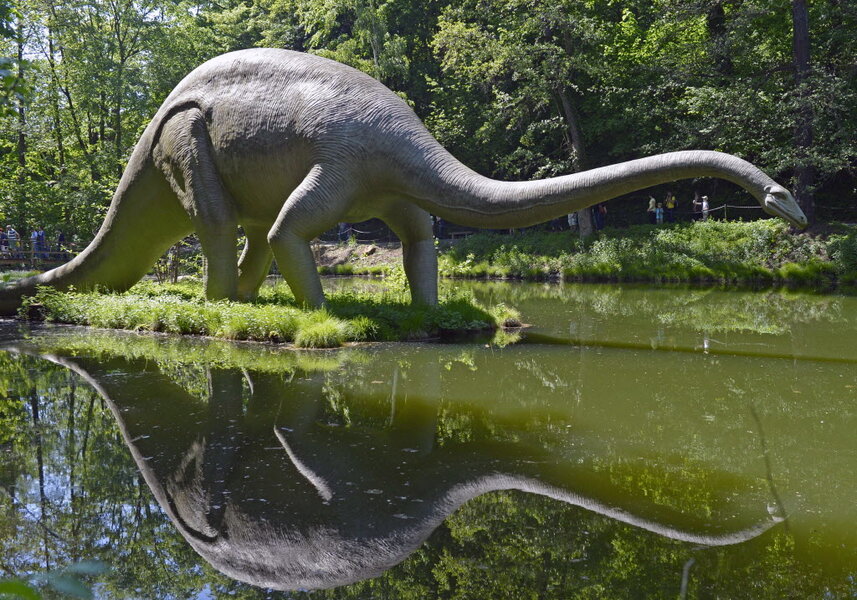No toothbrush required: Dinosaurs replaced their smile every month.
Loading...
Selling a toothbrush to a dinosaur would be a hard pitch.
A team of paleontologists found that gigantic “long-neck” herbivores packed up to nine reserve teeth in each tooth socket, regularly replacing their dulling teeth with fresh ones. That strategic tooth-replacement broadens the portrait of how the lumbering giants evolved and adapted to their ecosystem.
Adult sauropod dinosaurs, an order of vertebrate herbivores, had the largest body sizes of any terrestrial animal, reaching lengths of up to 100 feet. Sustaining that gargantuan bulk required an enormous amount of food, and the dinosaur’s teeth underwent significant abrasion from the constant eating.
So, over about 300 million years, those dinosaurs had to evolve some helpful dental infrastructure that would allow them to cope with the wear and tear.
“Sauropods have very simple teeth, so people have often thought of those dinosaurs as very basic and not very interesting,” said John Whitlock, a paleontologist at Carnegie Museum of Natural History and a lead author on the research, published in PLOS ONE. “But it turns out that those simple teeth are tied into this remarkable teeth replacement and adaptation.”
It has been known since at least the 1890s that most non-mammals, both modern and extinct, regularly exchange their teeth. That phenomenon has been well studied in several species of dinosaurs – including the T.rex, which shuffles its old teeth out about once a year – but the rate at which large herbivores replace their teeth had not been researched.
To better understand these huge animals’ dental scheme, researchers sectioned two Jurassic period sauropod jaws: one from a Camarasaurus, dug up in southern Utah, and the other from a Diplodocus, recovered in Colorado. Both sauropods lived some 150 million years ago in Laramidia, the densely populated island landmass that is the now the western North and South American spine.
CT scans were first taken of both jaws at the University of Michigan health center. The scientists then sectioned those jaws, removing not only the visible teeth, but also the backup teeth embedded behind them.
To determine how fast those replacement teeth were grown in, the scientists then looked at the dentin – the layer beneath the tooth enamel – in the dinosaurs’ current teeth. A new layer of dentin is added each day, and the resulting layers can be counted to show age, much as growth rings in a fish’s earbones reveal how many seasons the animal has weathered. The age of the current teeth was compared to the backup teeth to determine the rate at which the new teeth would have grown in.
Diplodocus was found to pack up to five teeth in each tooth socket, holding them in reserve to immediately replace a defunct tooth. It exchanged its small, narrow-crowned teeth about once a month.
Camarasaurus, less of a pack animal, had about three reinforcements waiting behind each functional tooth and switched out its larger, broad-crowned teeth about once every two months.
Using computer models, the researchers then extrapolated from those two data points to determine the rate of tooth exchange in other dinosaurs. One of them, Nigersaurus, is estimated to have replaced each tooth about every 14 days – the highest rate for any dinosaur – and to have kept up to nine teeth behind each tooth in use.
Whitlock compared those dinosaurs’ teeth replacement rates to an escalator – on an escalator with lots of people on it, a new person will arrive at the top at a faster rate than an escalator that has just a few people riding on it, just as Diplodocus’s packed teeth sockets will send up teeth at a faster rate than Camarasaurus’s less packed sockets. Teeth grow at a standard rate –
Camarasaurus’s replacement rate is also slower than Diplodocus’s rate because teeth grow at a standard speed – about 3 to 18 thousandths of a millimeter per day – and Camarasaurus has large teeth than require a longer growth period to reach their full size than do Diplodocus’ small ones.
The difference in dental infrastructure between large herbivores is correlated with differences in eating habits, though scientists aren’t sure whether the teeth or the diet came first – “It’s sort of a chicken and egg scenario,” said Whitlock.
Diplodocus is believed to have eaten low to the ground, while Camarasaurus feasted higher above, wresting leaves from the middle and top branches. Nigersaurus is a highly specialized Cretaceous period herbivore that sheared its food from plants using hundreds of tiny teeth.
Those distinctions in teeth and diet could be an important point in understanding how the Brobdingnagian dinosaurs managed to coexist. Earlier this week, scientists reported that a Nasutoceratops titusi skeleton unearthed in Utah provided evidence that Laramidia was home to at least two contemporaneous communities of dinosaurs, further complicating the already vexing question about how a fairly small plot of real estate was able to host so many species of dinosaurs.
“These dinosaurs had to eat a lot of plants get this large, so they were pretty devastating on local plant communities,” said Whitlock. “The best way to coexist was probably to specialize.”
This is not the first time that dinosaur teeth have undergirded larger questions about how dinosaurs lived millions of years ago. Earlier this week, a single T. Rex tooth extracted from the tail of an herbivore became a significant piece of evidence to a century-old debate among paleontologists about whether or not the dinosaur was a scavenger or a predator. That one tooth suggested that the carnivorous dinosaur hunted down its meal and could have been the king of its ecosystem.








